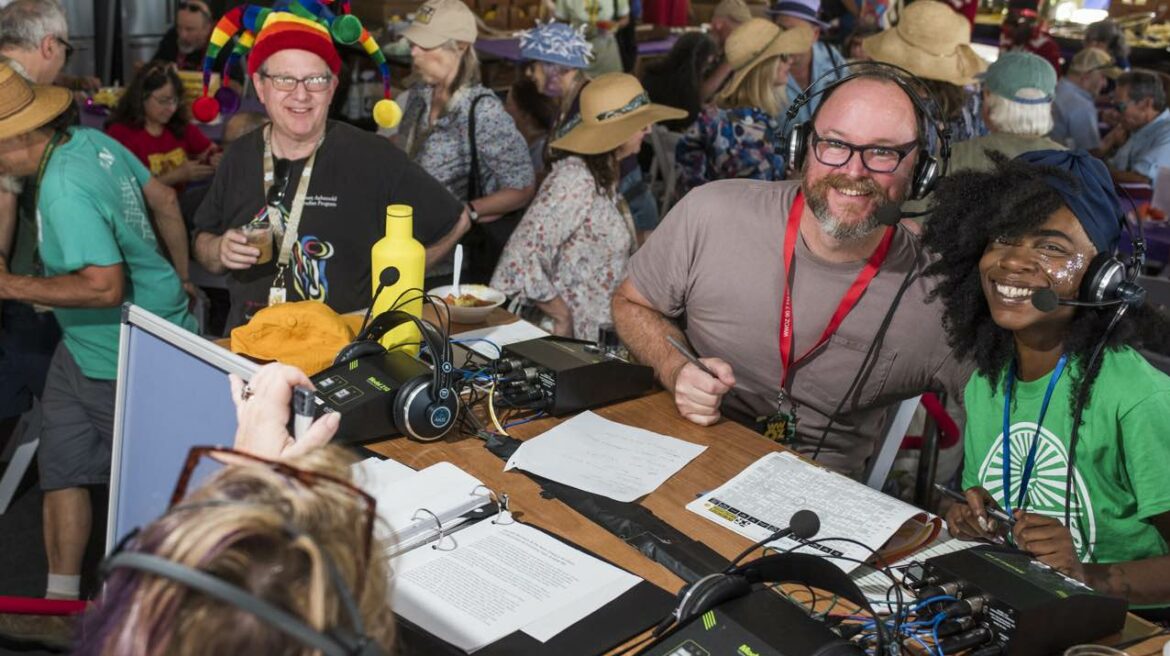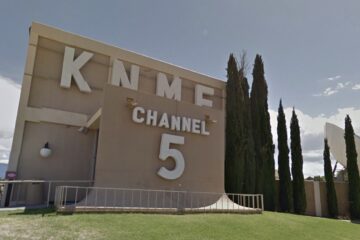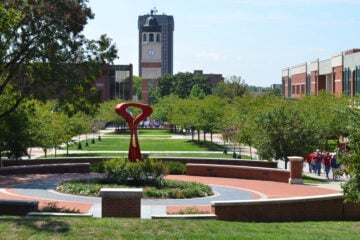Why ‘Bowling Alone’ falls short as a framework for civic engagement

Ryan Hodgson-Rigsbee
WWOZ volunteers DJ Swamp Boogie, left, and Cole Williams host a live broadcast from the New Orleans Jazz & Heritage Festival on April 27, 2019.
This commentary was first published in the National Federation of Community Broadcasters’ monthly newsletter and is republished here with permission.
It’s back-to-school time, and I often reflect on my days as a university professor and founding faculty member of Bay Path University’s nonprofit management and philanthropy program. I miss having an official excuse to buy a planner, notebook and new pens — though I still indulge in these small pleasures. I used to begin my first note to students with: “Brinnnggg! That’s the old sound of the school bell signaling the start of class.” This set the tone for open discussions, emphasizing the value of diverse opinions.
Recently, I was invited to a webinar on the role of public media in civic engagement and social capital, inspired by Robert Putnam’s Bowling Alone and the new documentary, Join or Die, a film about “why you should join a club.” This critique is my response to that discussion.
I graduated college in 1995, the same year Putnam’s Bowling Alone article was published, sparking debate among faculty and students in the cultural anthropology program, one of my majors. His 2000 book further fueled discussions on social capital, civic engagement and nonprofit management, especially in my graduate studies in 2001. Over the years, I’ve remained critical of Putnam’s framework, finding it oversimplified and limited, particularly regarding the experiences of women, BIPOC individuals, and Generations X and Y in building social capital.
What works well with ‘Bowling Alone’
Bowling Alone highlighted a decline of social connections in America and sparked a national conversation about the importance of community engagement. Putnam’s work raised awareness across the country, inspiring efforts to revive civic participation and influencing policies aimed at strengthening social bonds. The documentary film based on his book further amplified these discussions, from morning talk shows to the White House, encouraging people to invest in social capital and reconnect with their communities. This movement also fostered intergenerational conversations about the enduring value of staying socially engaged.
The problems with ‘Bowling Alone’
Putnam’s thesis suggests a decline in American social capital since the 1950s, using the metaphor of declining bowling league participation to illustrate reduced community involvement. He attributes this to factors like increased TV viewing, suburban sprawl and the rise of two-income households. However, his narrative often overlooks the complexities of race, gender and socio-economic dynamics, and the growth of the nonprofit sector.
Putnam fails to account for the diverse ways racial and ethnic groups engage in community-building. Black, Latinx, Asian and Indigenous communities have long developed unique social capital forms, often through religious institutions, ethnic affiliations and grassroots activism. His focus on traditional forms like PTA meetings neglects these vital contributions and, importantly, that folks of color were not always welcome in these institutions.
Similarly, his analysis underestimates how gender impacts civic engagement. For many Gen X and Gen Y women, workforce participation has opened new avenues for community involvement, from women’s organizations to digital platforms. These evolving forms of engagement challenge Putnam’s notion that social capital decline is primarily due to fewer face-to-face interactions.
Moreover, the socio-economic realities for Gen X and Gen Y, marked by job insecurity and economic precarity, have reshaped civic engagement. Traditional measures like homeownership are less feasible, but this does not signal a decline. Instead, there’s a shift towards more dynamic, digital forms of community-building that transcend geographical boundaries.
Contrary to Putnam’s argument, the nonprofit sector has expanded significantly, becoming a critical part of civic life. With nearly 2 million organizations generating trillions in revenue, nonprofits serve as modern social capital hubs, fostering engagement around common goals. This shift reflects a move from localized, face-to-face interactions to more organized, issue-based engagement, aligning with contemporary social and economic realities.
A different perspective: Asset-based framing
Putnam’s deficit-based framing suggests communities have lost something essential, portraying them as lacking. Instead, we should adopt an asset-based perspective, recognizing the strengths and contributions of communities before addressing their challenges. This shift in narrative fosters a more respectful and humane view of community worth and more importantly, a better description of our friends and neighbors who live in these communities.
While societal challenges like the global pandemic have heightened feelings of isolation and loneliness, civic engagement and social capital may not be declining but rather changing and evolving. We don’t know the full picture just based on Putnam’s framing because we need to develop different metrics to understand the full picture. The original metrics of participation in bowling leagues, Rotary Clubs and participation in PTA meetings started in a time when our country was segregated and women were not allowed in many spaces. Public media, especially community radio, plays a pivotal role in this evolution, promoting civic ties through more inclusive and diverse frameworks beyond Putnam’s. Can we do more? Of course!
Community radio’s role
The National Federation of Community Broadcasters is the oldest and largest national organization dedicated to supporting community stations within the public media system. We serve 200 member stations nationwide, with 57% of our members operating on budgets of less than $100,000 and 63% located in rural areas. NFCB member stations reach 2 million people across the United States. Next year, we will celebrate our 50th anniversary.
Community radio has always been a part of the public radio network, primarily because of its noncommercial status. However, the management, operation and program development of community radio stations differs significantly from other public radio stations. Community radio stations primarily rely on volunteers and emphasize community service, listener involvement and participation as their core philosophy. At most community radio stations, hosts and DJs are volunteers. Some of our low-power FM stations may operate with just two or three people managing everything. Unlike public radio, community radio focuses on hyper-local connections because the stations are literally powered by volunteers from the communities they serve.
Nathan Moore, an NFCB board member, is GM of WTJU, a community radio station affiliated with the University of Virginia in Charlottesville. He told me that his station involves 300 volunteers, including high school and college students, who help deliver programs and organize community events. That number is indeed impressive and cannot be replicated by everyone, but my point is that ALL community radio stations rely on volunteers as a norm. It is part of their business model. This is a different community-based practice than those of our public radio counterparts. More importantly, the use of community volunteers is an essential reflection of the mission of community radio to value local content and public service.
Community radio has often been overlooked as an essential part of the civic information ecosystem, yet NFCB and its members have been steadfast advocates for building social capital in communities. Community radio stations are in communities across the United States, partnering with local nonprofits and businesses to keep their communities going.
Listening Post Collective
A recent NFCB newsletter highlighted a new partnership with the Listening Post Collective. The LPC seeks to create a more equitable civic information infrastructure across the U.S., ensuring that all communities, especially those historically marginalized in media and democracy, have access to high-quality, culturally relevant information. In their work both internationally and domestically, LPC emphasizes understanding civic ties and social capital within communities through an asset-framing model, which is detailed in their DIY Civic Media Playbook. This model prioritizes mapping community assets and centering marginalized voices.
Asset-based mapping and Asset-Based Community Development in the U.S. were pioneered by John McKnight and John Kretzmann. In 1993, they published “Building Communities from the Inside Out: A Path Toward Finding and Mobilizing a Community’s Assets,” which laid the groundwork for this approach. This framework and model is much more inclusive than Putnam’s since it also recognizes the need and role for social justice across communities.
Why this matters to public media
My intention in discussing Bowling Alone isn’t to criticize it for the sake of critique. Instead, I aim to encourage those of us in public media to consider the limitations of this framework before it gains widespread acceptance in our sector. I want to avoid a situation similar to the one we are experiencing with the “news desert” narrative, which has permeated the public media network.
The term “news deserts” typically refers only to communities that have lost their legacy newspapers. However, this definition overlooks the presence of other news and information sources that may still be active in those areas, such as online publications, public media, regional TV news or ethnic news outlets. In public media, we often perpetuate the news desert narrative without seeking out more nuanced data that could provide a fuller picture. It’s our responsibility to look deeper. As a sector, we should strive to make decisions that are informed by multiple data sets, ensuring a more comprehensive understanding. (Do check out Poynter’s new report offering a different framing to the “news desert” issue.)
As mentioned earlier, community radio is a vital component of the civic information ecosystem in many communities, and this role is frequently overlooked. NFCB has numerous stories from our member stations that support this claim, but we currently lack hard data. We are actively working to address this gap by gathering data that will allow us to better articulate and substantiate what NFCB is observing at a hyper-local level.
Closing thought
So, am I saying that all is rosy with our communities? No! The rate of loneliness, anxiety and depression are up across all our residents in this country. While digital connections have boosted some areas of civic engagement, there continues to be a real digital divide in our country.
My critique and offered reframing here is that we need to look at more inclusive models to measure civic participation and social capital. My call to action is to simply ask that we consider a framework of inclusivity; to include lived realities and experiences of women and BIPOC folks across the generations.
To truly understand civic life today, we must look beyond the binary of decline and revival. Let’s consider how people are finding new ways to connect and build community in a rapidly changing world. Civic engagement and social capital are evolving to meet the needs of contemporary society. Public media, particularly community radio, has a significant role in strengthening civic ties and building social capital. We must explore frameworks beyond Putnam’s Bowling Alone for this work. And yes, we can include Putnam’s work in our analysis too; it just can’t be the only framing.

To truly capture today’s civic and social capital landscape, we need metrics that reflect the varied experiences of BIPOC communities and women across generations. Let’s continue this conversation — reach out at rima@nfcb.org. With that, wishing everyone a great back-to-school season.
NFCB CEO A. Rima Dael has over 30 years of experience working with nonprofit organizations in the public media, arts, education and human service sectors. Before joining NFCB, she worked as GM of WSHU Public Radio in Fairfield, Conn., and served as an NPR board member. She also directed development at New England Public Media in Springfield, Mass. Earlier in her career, she was a founding faculty member of Bay Path University’s nonprofit management and philanthropy master’s degree program and executive director of Country Dance and Song Society.





